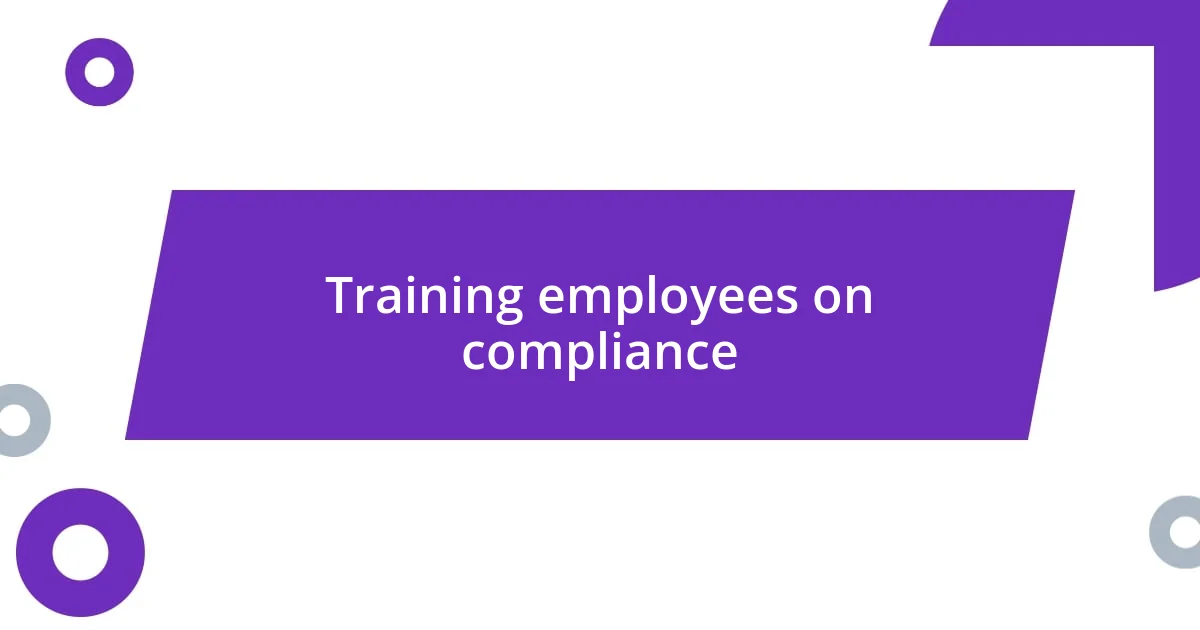Key takeaways:
- Understanding compliance guidelines is crucial for organizations to meet legal and ethical obligations, transforming compliance from a chore into a valued aspect of integrity and reputation.
- Effective identification and ongoing assessment of compliance requirements involve research, stakeholder engagement, and adaptability to regulatory changes, fostering a culture of accountability.
- Regular compliance training and open communication play key roles in addressing issues, enhancing team engagement, and celebrating successes, ultimately creating a supportive environment for continuous improvement.

Understanding compliance guidelines
Compliance guidelines are essentially the rules and standards that organizations must follow to ensure they meet legal and ethical obligations. I remember sitting in a workshop where a compliance officer shared a story about a company that faced severe penalties simply because they didn’t fully grasp these guidelines. It made me think: how often do we consider the broader implications of compliance on our daily operations?
When I first encountered compliance guidelines, they felt overwhelming—like an endless labyrinth of rules. But as I began to study them more closely, I realized they are designed to protect both the organization and its stakeholders. Have you ever considered how often these guidelines reflect ethical practices that go beyond just avoiding penalties? It’s a fascinating intersection of law, morality, and business.
I’ve seen firsthand how effective training on these guidelines can transform an organization. A colleague of mine once implemented a compliance training session that not only clarified the guidelines but made them relatable through real-life examples. The transformation was remarkable; the team went from viewing compliance as a chore to seeing it as an essential part of their integrity and reputation. Isn’t it inspiring how understanding these guidelines can pave the way for a stronger, more principled workplace?

Identifying key compliance requirements
Identifying key compliance requirements can feel like piecing together a complex puzzle, but it’s essential for any organization aiming to thrive. During my experience in compliance management, I discovered that starting with the foundational regulations related to your industry is crucial. This initial step not only builds a comprehensive understanding but also highlights any nuances relevant to your specific context. I remember a project where we meticulously mapped out compliance requirements, leading to a significant reduction in audit discrepancies.
To effectively identify these key requirements, consider the following:
- Research Industry Regulations: Familiarize yourself with laws and standards specific to your sector, whether it’s healthcare, finance, or another field.
- Engage Stakeholders: Communicate with team members across different departments to understand their perspectives and potential compliance challenges.
- Utilize Compliance Tools: Leverage software and frameworks that facilitate the identification and tracking of compliance obligations.
- Review Past Audits: Analyze previous audit reports to uncover recurring issues or overlooked compliance areas.
- Adapt to Changes: Stay updated on changes in legislation or industry standards that could impact compliance requirements.
By incorporating these practices, organizations can simplify the process of identifying key compliance requirements and foster a culture of accountability.

Developing a compliance plan
Developing a compliance plan involves careful strategizing that aligns with both regulatory requirements and organizational objectives. I’ve witnessed how a well-structured compliance plan can act like a roadmap, ensuring everyone in the organization knows their responsibilities. For instance, in one of my previous roles, we created a plan that not only included compliance requirements but also established clear roles and timelines. It felt empowering to see the team rally around a shared goal, knowing we were all on the same page when it came to compliance.
The beauty of a compliance plan is its flexibility. It should evolve along with your organization and the external environment. I recall a particularly challenging period when our sector experienced rapid legislative changes. My team and I met regularly to assess our compliance plan, tweaking it as necessary to align with new regulations. This proactive approach instilled a sense of resilience within the team, as we became more adept at navigating uncertainty together. Have you ever felt the satisfaction of adapting quickly to a challenging situation? It can be incredibly fulfilling.
Lastly, incorporating feedback mechanisms into your compliance plan can be a game-changer. Establishing regular check-ins allows for ongoing assessment and adjustments, ensuring that compliance isn’t just a one-time effort but an ongoing commitment. In my experience, conducting surveys within the team brought to light unforeseen compliance concerns, allowing us to address them promptly. The sentiment in the organization shifted from merely following rules to genuinely caring about our compliance practices. How can we cultivate this sense of ownership within our teams?
| Component | Details |
|---|---|
| Compliance Objectives | Clearly defined goals tailored to regulatory requirements. |
| Roles and Responsibilities | Assigned tasks to various team members to facilitate ownership. |
| Training and Education | Regular training sessions to keep the team informed and engaged. |
| Monitoring and Feedback | Continuous assessment and open channels for feedback and adjustment. |

Implementing compliance monitoring tools
Implementing compliance monitoring tools is a vital step in ensuring that your organization adheres to established guidelines. I’ve found that selecting the right tools can often feel daunting due to the sheer number available. For instance, when our team adopted a compliance management software, we not only streamlined our processes but also significantly reduced the time spent on tracking requirements. It was like turning on a light in a dim room—suddenly, everything was clearer.
Once we integrated the tools, I was pleasantly surprised by how they fostered a culture of accountability. Team members could instantly see which compliance tasks were pending, pushing everyone to engage in best practices actively. I remember one team member expressing relief when they realized the tool would send reminders for important deadlines; it took a lot of pressure off their shoulders. Wouldn’t you agree that having that kind of support makes a world of difference?
What I truly appreciate about these tools is their adaptability. We regularly review our compliance software to ensure it meets our evolving needs, keeping pace with regulatory changes. There was a period when a new law came into effect, and I can vividly recall our team’s collaborative effort to reconfigure our monitoring system. The sense of camaraderie and shared purpose in those moments was invigorating. How often do we have the chance to bond over shared challenges while ensuring our organization stays compliant? It’s a remarkable journey when technology complements our efforts to maintain integrity in our operations.

Conducting regular compliance audits
Conducting regular compliance audits is essential to maintaining an organization’s commitment to compliance. I remember the first time my team conducted a compliance audit; it felt a bit like a spring cleaning. We meticulously reviewed every policy and practice, and I was surprised by how many small issues emerged that we had previously overlooked. It was eye-opening to see those details, and tackling them together fostered a sense of teamwork that was invigorating. Have you ever felt that rush when uncovering insights that could really make a difference?
In my experience, these audits are not just about checking boxes; they’re opportunities for growth and learning. During one audit, we discovered that several departments had misunderstood key compliance guidelines. Instead of reprimanding anyone, we seized the moment to provide additional training. The smiles on my colleagues’ faces as they grasped the concepts while participating in an open, collaborative discussion made it clear that audits can be a platform for connection and improvement. What better way to turn a potentially dreary task into a chance for positive engagement?
The real magic of regular compliance audits lies in the insights they provide for refining both our practices and our compliance plan. Each audit unveils patterns that highlight where we need to improve, sparking rich conversations about how we can better align our operations with our goals. I’ll never forget a particularly robust discussion that arose after a recent audit, where team members passionately exchanged ideas on enhancing our compliance culture. Those moments inspire genuine commitment and creativity. Isn’t it fascinating how audits can catalyze transformative change within an organization?

Training employees on compliance
Training employees on compliance is a cornerstone of ensuring consistent adherence to guidelines. I recall a time when we rolled out a compliance training program and how skeptical some team members were about its necessity. Yet, as we engaged in interactive discussions, I witnessed a shift; they began to understand not just the “what” but the “why” behind compliance. Isn’t it amazing how understanding can foster a culture of awareness?
I personally love incorporating real-world scenarios into training sessions, as they spark a level of engagement that textbook learning often misses. One memorable experience involved role-playing a compliance breach scenario, where employees had to decide how to react in real time. The conversations that followed were rich with insight, and I could see the participants’ wheels turning as they reflected on how they might handle similar situations in their roles. This active participation created a safe space for them to voice their thoughts and learn from one another. Don’t you think that type of dialogue leads to stronger retention?
Continuous compliance training is not a one-and-done event; it requires regular refreshers to keep the material fresh and relevant. I’ve initiated quarterly check-ins that not only reinforce previous training but also introduce updates based on recent regulatory changes. After one session, a colleague approached me, excited to share how a new policy change would impact their department. Their enthusiasm reminded me that training can be a springboard for innovation rather than a mere obligation. How often do we overlook the potential for growth lying within the framework of compliance?

Addressing compliance issues effectively
Addressing compliance issues effectively often starts with proactive communication. I recall an incident where a new regulation took effect, and many team members were unsure how it applied to their roles. Instead of letting confusion linger, I organized an informal coffee chat where my colleagues could voice their concerns. The open dialogue created an atmosphere of trust and clarity, helping everyone feel more connected to the compliance process. Have you ever noticed how much smoother things go when you simply invite conversation?
Another key strategy I’ve found useful is documenting compliance issues as they arise. I remember a particularly challenging project where compliance questions kept cropping up. By keeping a shared document where everyone could log their queries and experiences, we transformed a reactive approach into a collaborative learning opportunity. This not only helped us address issues promptly but also built a valuable repository of insights that informed our future efforts. Isn’t it surprising how a simple document can shift the narrative from confusion to a shared resource for growth?
Lastly, I believe in celebrating compliance successes, no matter how small. Once, after resolving a compliance issue that had been a thorn in our side, I dedicated a team meeting to recognize everyone’s hard work in overcoming that challenge. The smiles and sense of accomplishment in the room were palpable. It was a reminder that compliance isn’t just a series of obligations; it’s a continuous journey where victories should be celebrated, fostering morale and encouraging ongoing commitment. How often do we take a moment to reflect and celebrate in our fast-paced environments?














